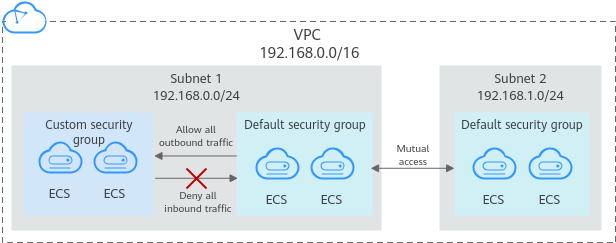Default Security Group and Its Rules¶
If you have not created any security groups yet, the system automatically creates a default security group for you and associates it with the instance when you create it. A default security group has the following rules:
Inbound rules control incoming traffic to instances in a security group. Only instances in the same security group can communicate with each other, and all inbound requests are denied.
Outbound rules allow all outbound traffic and response traffic to the outbound requests.

Figure 1 Default security group¶
Note
You cannot delete the default security group, but you can modify existing rules or add rules to the group.
The default security group denies all external requests. To log in to an instance associated with this security group, add a security group rule by referring to Remotely Logging In to an ECS from a Local Server.
Table 1 describes the default rules for the default security group.
Direction | Action | Type | Protocol & Port | Source/Destination | Description |
|---|---|---|---|---|---|
Inbound | Allow | IPv4 | TCP: 22 | Source: 0.0.0.0/0 | Allows IPv4 traffic to reach instances in the security group over SSH port 22 for remotely logging in to Linux instances. |
Inbound | Allow | IPv4 | TCP: 3389 | Source: 0.0.0.0/0 | Allows IPv4 traffic to reach instances in the security group over RDP port 3389 for remotely logging in to Windows instances. |
Inbound | Allow | IPv4 | TCP: 80 | Source: 0.0.0.0/0 | Allows IPv4 traffic to reach the websites deployed on the instances in the security group over HTTP port 80. |
Inbound | Allow | IPv4 | TCP: 443 | Source: 0.0.0.0/0 | Allows IPv4 traffic to reach the websites deployed on the instances in the security group over HTTPS port 443. |
Inbound | Allow | IPv4 | ICMP: all | Source: 0.0.0.0/0 | Allows external IPv4 servers to ping the instances in the security group to verify the network connectivity. |
Inbound | Allow | IPv4 | All | Source: Default security group (default) | Allows IPv4 instances in the security group to communicate with each other using any protocol over any port. |
Inbound | Allow | IPv6 | All | Source: Default security group (default) | Allows IPv6 instances in the security group to communicate with each other using any protocol over any port. |
Outbound | Allow | IPv4 | All | Destination: 0.0.0.0/0 | Allows all traffic from the instances in the security group to any IPv4 address over any port. |
Outbound | Allow | IPv6 | All | Destination: ::/0 | Allows all traffic from the instances in the security group to any IPv6 address over any port. |